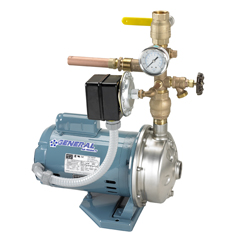
In a word: corrosion.
In a far more important word: safety.
Many booster pumps installed in NFPA 13D applications use the slightly cheaper yet much less safe alternative cast iron components, which are highly susceptible to corrosion. To understand this better, let’s look at the timeline:
An NFPA 13D system (who’s booster pump is complete with a cast iron pump head and components) is installed and tested, and everything checks out. Right on.
Now your system sits – for years – maybe decades, without so much as a kick to the pump. Remember, there is currently no ITM required in NFPA 13D homes. Through the years, water sits ready inside the pump head, waiting for a trip in the system. This standing water will certainly cause localized corrosion when left untreated.
A corroded pump head can result in decreased pressure and flow to a tripped sprinkler when it matters most but the biggest concern here is a failure of the pump to start up. Corrosion between the blade and internal wall of the pump or just on the internal wall of the pump can prevent the pump from turning.
In the Fire Protection Industry we all know the value of reliability in our products, because it can mean the difference between life and tragedy. This rings all the too true in single family homes, where fires often occur when occupants are either asleep or at their most vulnerable. That’s why we’ve never built a 13D Fire at General Air Products with anything but stainless steel pumps and nonferrous components – and why you should never install one without them.